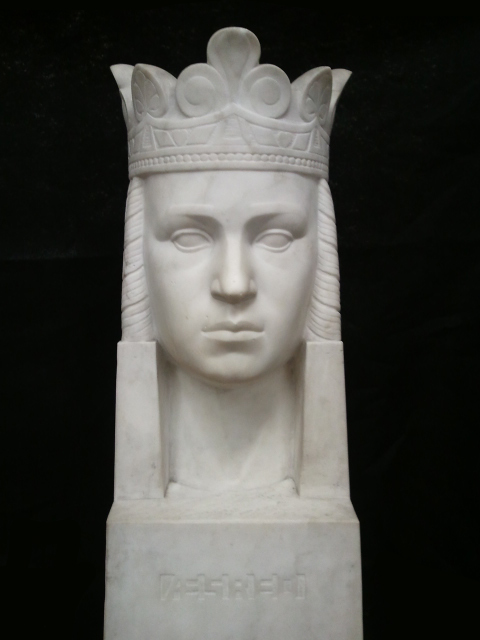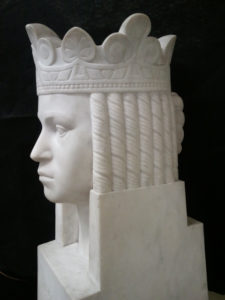
Special Collections and Archives, VCU Libraries
This sculpture was given to James Branch Cabell by Amateis in 1927. It remained at the Cabell home on Monument Avenue until the 1970s when it was given to James Branch Cabell Library.
In Autumn 1931, James Branch Cabell published a work of creative non-fiction in Virginia Quarterly Review titled “Before Aesred.” The essay takes the form of musings as Cabell sits at his typewriter in front of Amateis’ marble bust of Aesred. Cabell imagines himself as a postulant before Aesred, a goddess who has appeared in many forms: first as an Earth goddess — an All-Mother — but to later cults as an “All-Wife,” and an agent of civilization, “who teaches all to conform the one with another.” Cabell says of her, “In the mythology of Poictesme there was, save only Kosh-chei the Deathless, none more mighty than Aesred, Our Lady of Compromise.” Aesred the “plump and slightly sullen goddess” observes the author without sympathy or bitterness, because her contempt for him is complete.

Special Collections and Archives, VCU Libraries
Cabell goes on to ponder other mythological conceptions of womanhood who may bring ecstasy, but not Aesred’s wisdom. He brings to mind Lady Beauty, La Belle Dame San Merci, Lilith, the Queen of Faery, Ettarre and the Witch-Woman while he muses on their relation to the writer and the romantic. Cabell acknowledges Aesred’s wisdom, but hears the call of Ettarre as sweeter, though it draws men to their doom.
For Ettarre teaches that the ways of conformity are wise but ignoble; that the respect of the dullwitted and of the cowed is an honor somewhat incriminating; and that her secret knowledge, if only we could master it, may yet lead some of us, among dim byways, toward that unique land in which one may live, perhaps, with more competence. Even in the ambiguity of that half-promise she lies, no doubt; but she remains wholly lovely. She is the lady in domnei of all true romantics, whether they be young or old.
For Cabell, his shifting visions of womanhood and their meaning before the statue end with an adjustment of his reading glasses. The writer claims to make his choice:
I find it therefore a considerable comfort that my reading glasses should require but an instant to convert Aesred into Ettarre; and it is before the unreal vision begotten by the frailty of my failing eyes, and not before any adroitly, carven stone, that I now bend in the attitude of a postulant. I then insert yet another sheet of paper into my typewriter, and I begin upon a new paragraph of that especial sort of nonsense which happens to divert me more affably than does Aesred’s wisdom.
Read “Before Aesred” in its entirety: Virginia Quarterly Review vol, 7, no. 4, (Autumn 1931).